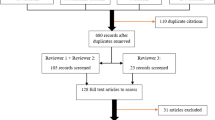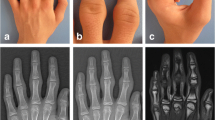Abstract
Pachydermodactyly is a rare digital fibromatosis characterized by asymptomatic fusiform soft-tissue swellings of the proximal interphalangeal joints of the hands. It usually affects healthy adolescent males with a negative family history. As a rule, clinical presentation of the disease is bilateral and symmetrical enlargement of the joints. So it can be misdiagnosed with inflammatory rheumatic diseases, especially with juvenile chronic arthritis. A prompt clinical diagnosis of the disease would prevent inappropriate treatment with immunosuppressive agents or steroids and unnecessary expensive diagnostic procedures such as biopsy or magnetic resonance imaging. Once diagnosed, patients should be advised in order to avoid repetitive traumas of the hands, rubbing and cracking of the fingers, obsessive–compulsive use of computer and video games. The joint outcome is always benign. Here, we report a case of pachydermodactyly differs from the typical clinical picture of pachydermodactyly in the unilateral distribution of the lesions.


Similar content being viewed by others
References
Basex A, Dupre A, Teillard J (1973) Pachydermie digitale des premie`res phalanges par hyperplasie conjonctive dermique et aplasie hypodermique. Bull Soc Fr Dermatol Syphiligr 80:455–458
Verbov J (1975) Pachydermodactyly: a variant of the true knuckle pad. Arch Dermatol 111:524
Beltraminelli H, Itin P (2009) Pachydermodactyly–just a sign of emotional distress. Eur J Dermatol 19:5–13
Martin JC, Rennie JAN, Kerr KM (1992) Pachydermodactyly: confused with JCA. Ann Rheum Dis 51:1101–1102
Shuang Y, Shun-Le C, Yu-Qi D, Fen L, Qiang G, Chun-De B (2005) Pachydermodactyly: six new cases from China. J Clin Rheumatol 11:72–75
Anandacoomarasami A, Bak AS, Peduto A (2005) Magnetic resonace imaging in pachydermodactyly. J Rheumatol 32:2239–2241
Sandobal C, Kuznietz A, Varizat A, Roverano S, Paira S (2007) Pachydermodactyly: four additional cases. Clin Rheumatol 26:962–964
Taylor-Gjevre R, Saxena A, El Maadawy S, Classen D, Nair B, Gjevre J (2009) A case of deforming pachydermodactyly. J Clin Rheumatol 15:78–80
Itin PH, Lautenschlager S (1995) Pachydermodactyly: a psychocutaneous disorder. Dermatology 190:1–3
Cabanillas M, Monteagudo B, Leon-Muinos E, Suarez-Amor O (2010) Pachydermodactyly in a young girl: cutaneous manifestation of a psychiatric disorder? Pediatr Dermatol 27:306–308
Veraldi S, Rizzitelli G, Brusasco A (1996) Pachydermodactyly of a single finger. Eur J Dermatol 6:576–578
Saka B, Mezdegi A, Ozturk A, Erten N, Cefle K, Palanduz S (2005) Two siblings with distal pachydermodactly. Clin Exp Dermatol 30:707–709
Tompkins SD, McNutt NS, Shea CR (1998) Distal pachydermodactyly. J Am Acad Dermatol 38:359–362
Reichert CM, Costa J, Barsky SH, Claysmith AP, Liotta LA, Enzinger FM et al (1985) Pachydermodactyly. Clin Orthop Relat Res 194:252–257
Lo WL, Wong CK (1993) Localized pachydermodactily in tuberous sclerosis. Clin Exp Dermatol 18:146–147
Bardazzi F, Neri I, Fanti PA, Patrizi A (1996) Pachydermodactyly in two young girls. Pediatr Dermatol 13:288–291
Callot V, Wechsler J, Hovnanian A, Revuz J (1996) Pachydermodactyly and atrophia maculosa varioliformis cutis. Dermatology 190:56–58
Woodrow SL, Burrow NO (2003) Pachydermodactyly in association with Asperger syndrome. Clin Exp Dermatol 28:674–675
Ehl S, Uhl M, Berner R, Bonafe L, Superti-Furga A, Kirchhoff A (2004) Clinical, radiographic, and genetic diagnosis of progressive pseudorheumatoid dysplasia in a patient with severe polyarthropathy. Rheumatol Int 24:53–56
Kaya A, Ozgocmen S, Kiris A (2005) Ciftci I (2005) Clinical and radiological diagnosis of progressive pseudorheumatoid dysplasia in two sisters with severe polyarthropathy. Clin Rheumatol 24:560–564
Sinha GP, Curtis P, Haigh D, Lealman GT, Dodds W, Bennett CP (1997) Pachydermoperiostosis in childhood. Br J Rheumatol 36:1224–1227
Guberman D, Lichtenstein DA, Vardy DA (1996) Knuckle pads—a forgotten skin condition: report of a case and review of the literature. Cutis 57:241–242
Calikoglu E (2003) Pseudo-knuckle pads: an unusual cutaneous sign of obsessive-compulsive disorder in adolescent patient. Turk J Pediatr 45:348–349
Wollina U (2005) Chewing pads versus pachydermodactily: comment on the clinical image by Akikusa et al. Arthritis Rheum 52:2953
Mangat P, Jawad AS (2005) Case number 32: Thiemann’s disease. Ann Rheum Dis 64:11–12
Meunier L, Pailler C, Barneon G, Meynadier J (1994) Pachydermodactyly or acquired digital fibromatosis. Br J Dermatol 131:744–746
Aoki K, Iida H, Umeda T (1994) A case of pachydermodactyly. Jpn J Plast Reconstr Surg 37:109–113
Lautenschlager S, Itin PH, Rufli T (1994) Pachydermodactyly: reflecting obsessive-compulsive behavior? Arch Dermatol 130:387
Iraci S, Bianchi L, Innocenzi D et al (1993) Pachydermodactyly: a case of an unusual type of reactive digital fibromatosis. Arch Dermatol 129:247–248
Author information
Authors and Affiliations
Corresponding author
Rights and permissions
About this article
Cite this article
Ulusoy, H., Tas, N.P., Akgol, G. et al. Unusual unilateral presentation of pachydermodactyly: a case report. Rheumatol Int 32, 1747–1750 (2012). https://doi.org/10.1007/s00296-011-1895-x
Received:
Accepted:
Published:
Issue Date:
DOI: https://doi.org/10.1007/s00296-011-1895-x




